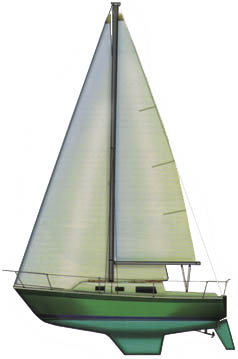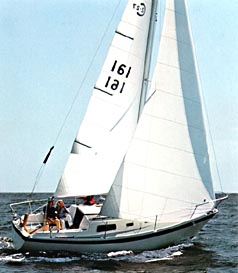The
Cal 2-27
Solid,
nimble weekender
By Dieter Loibner
(originally published in Sailing magazine, January 1998)
Sailing a Cal 2-27 after a spin on a modern sport boat design is
like petting a benign St. Bernard after escaping a vicious and hyperactive
Chihuahua. It also makes for an interesting trip back in time to
the early 1970’s, when the lines in the gas stations were long
and retractable bowsprits, asymmetrical chutes, lifting keels and
carbon-fiber masts were not even imagined.
Boats were built differently before space age technology became
a common ingredient of yacht design. Family and comfort were as
important as safety and all-around performance. This is evident
with the Cal 2-27, which offers more than 6 feet of standing headroom,
a real head, and cozy accommodations - all in a little 27-footer.
Bill Lapworth designed the Cal 2-27 in 1973 for Jensen Marine (also
known as Cal-Boats) in Costa Mesa, California., which produced the
boat from 1974 to 1980. The 2-27 followed the original Cal 27, a
boat with a pop-top cabin-house and less than stellar performance.
The successor offered 4 inches more beam and 5 inches less DWL but
1,300 pounds more displacement. Cal Boats already had success with
the Cal 29, but looked for a similar design that was smaller and
more in tune with the struggling economy. Later, Lapworth designed
the Cal 3-27, which was launched in 1983 and underwent a rather
confusing name change back to Cal 27 before it was taken off the
assembly line in 1985.
Cal-Boats was purchased by Bangor Punta in 1965, moved from Southern
California to Florida in 1980 and then on to Massachusetts in 1985
before it closed shop. Reliable information or spare parts are thus
sometimes hard to come by and best obtained from longtime owners.
"Strict class rules and solid construction have secured the survival
of the Cal 2-27", said Paul Shinoff, who has owned one since 1987.
"I thought of buying a bigger and faster boat but stuck with my
2-27." Looking at a 2-27, the boat appears overbuilt and underpowered
by todays standards - part of the reason for its longevity.
"A 2-27 holds its market value well as long as the basic maintenance
has been done", explained Mark Foster, former secretary of the very
active San Francisco Bay fleet and an avid campaigner of the gemlike
2-27 Alliance. The fun starts at $12,000 to $15,000 for
a 1976 model or later that is ready to sail. Pristine Cals go for
more but sometimes one can get lucky and find a fixer for under
$10,000.
Longtime owners will point out that an area for scrutiny on used
2-27’s is the untapered deck-stepped mast. "It is crucial to
replace the old wires," Foster said. Several years ago Steve Seal,
who worked as a rigger with Cal-Boats, noted that three Cal 2-27’s
lost their rigs. He looked into the matter and concluded that the
wires were undersized. "Headstay, backstay and upper shrouds were
3/16 inch, but should really be 7/32 inch. The lower shrouds were
7/32 inch, but should be 1/4 inch," Seal said. "If the mast has
the original spruce spreaders, they need to be checked too. My tip
is to paint the topsides white and leave them in natural varnish
on the bottom." The upgraded standing rigging will run about $120
per stay, turnbuckles included. Seal also recommends a stainless
maststep plate for the cabintop, with holes for vang and downhaul,
so drilling through the cabintop is unnecessary.
Pre-owned and saltwater-sailed Cal 2-27’s often come with corroded
booms, which can snap at the point where the stainless steel collar
of the vang is riveted to the aluminum. Seal replaces them with
the stock extrusion but puts a reinforcement tube and a pad eye
inside before he cuts the slots for vang and outhaul. Estimated
cost for a completely rigged boom is about $900.
The hull is solidly laminated in fiberglass with bulkheads that
are bonded to hull and deck. The hull-deck joint is glued with a
mix of resin and glass. Often this area requires resealing to stop
annoying leaks. Finding the correct backing plates for deck hardware
can be a potential problem but most owners have found a solution
with custom made parts.
The interior offers lots of wood, four generously sized berths and
a compact gallery that is integrated with the steps of the companionway,
while the top-loading icebox is in the port corner of the galley
counter. The original alcohol stove, termed a nuisance, spawned
creative ideas for a replacement. On Alliance a gimballed
single-burner camping stove is installed on top of the companionway
which, though inconvenient to traffic between deck and cabin, keeps
cooking odors out.
The most important upgrades for the performance-minded Cal sailor
are additional jib tracks, a set of modern winches on the cabin
top and purchasing a chute. "The headsail drives the boat, especially
in light air when we use a 155-percent jib," Shinoff said. "It needs
to be sheeted on the toerail and improves performance, but it is
demanding on the crew." The 120-percent class jib is sheeted on
the cabintop in light air, and switched to the original track on
the side deck when the breeze is up. In this case the sheets run
between the upper and lower shroud. Originally, the Cal 2-27 didn't
fly a chute, even though many owners upgraded for PHRF racing (198
rating), class racing still eschews colored nylon. Mylar and 3-DL
are strictly outlawed; however, full-battened mainsails are permitted
for racing.
The Cal 2-27 came with either the Atomic Four or, later on, a one
cylinder Farymann diesel. Either way, the engine will eventually
need a major overhaul.
Bottom line
The Cal 2-27 is a reliable day or weekend cruiser that is raced
in class or PHRF handicap events. Best suited for winds in the low
to mid-teens, the Cal 2-27 won’t dazzle with record speeds
but offers enjoyable cruising with the comfort of the good old days.
She prefers flat water but will put up with ocean swells too. The
boat has a unique charm; its weaknesses can be corrected with reasonable
financial effort. Sailors with some do-it-yourself skills can purchase
a boat in decent shape for less than $15,000 and restore it to Bristol
condition. So what is a little sweat-equity compared to 50 grand
for a new design that barely offers enough creature comfort for
a dog.
Dieter Loibner, Sailing’s West Coast editor, has a doctorate
in journalism. Born in Austria, Loibner now resides in Oakland,
California, where he is an avid small and large boat sailor.
Sources
Cal 2-27 parts supplier:
Seal's Spars & Rigging, Alameda, California, Steve Seal (510) 521-7730
Sailmaker: Pineapple Sails (510) 444-4321
Miscellaneous deck hardware: Defender (800) 628-8225 |
 |
Specifications
LOA:
26'7"
LWL: 22'1"
Beam: 9'3"
Draft: 4'3"
Displacement: 6,700 pounds
Ballast: 3,100 pounds
Sail Area: 374 sq. ft. |
Project
List
1. Replace rigging shrouds
2. Check spreaders
3. Reinforce boom section
4. Replace stainless maststep plate
5. Reseal hull-deck joint
6. Install additional jib tracks, if racing
7. Install winches, if racing
8. Have sails made |
Cost
Summary
Boat
(1976 model) $12,000
Rigging stays (6): $720
Maststep plate: $90
Boom reinforcement: $30
New main and jib: $2,258
(5.5-ounce, Dacron, 120% jib
Total: $15,098 |
 |
|

